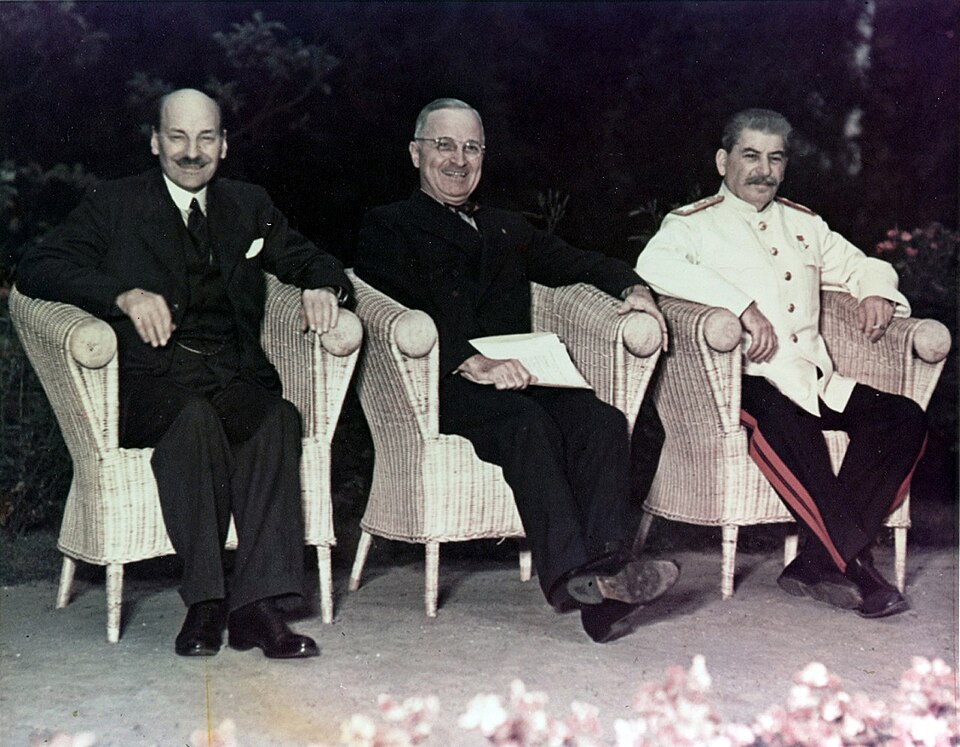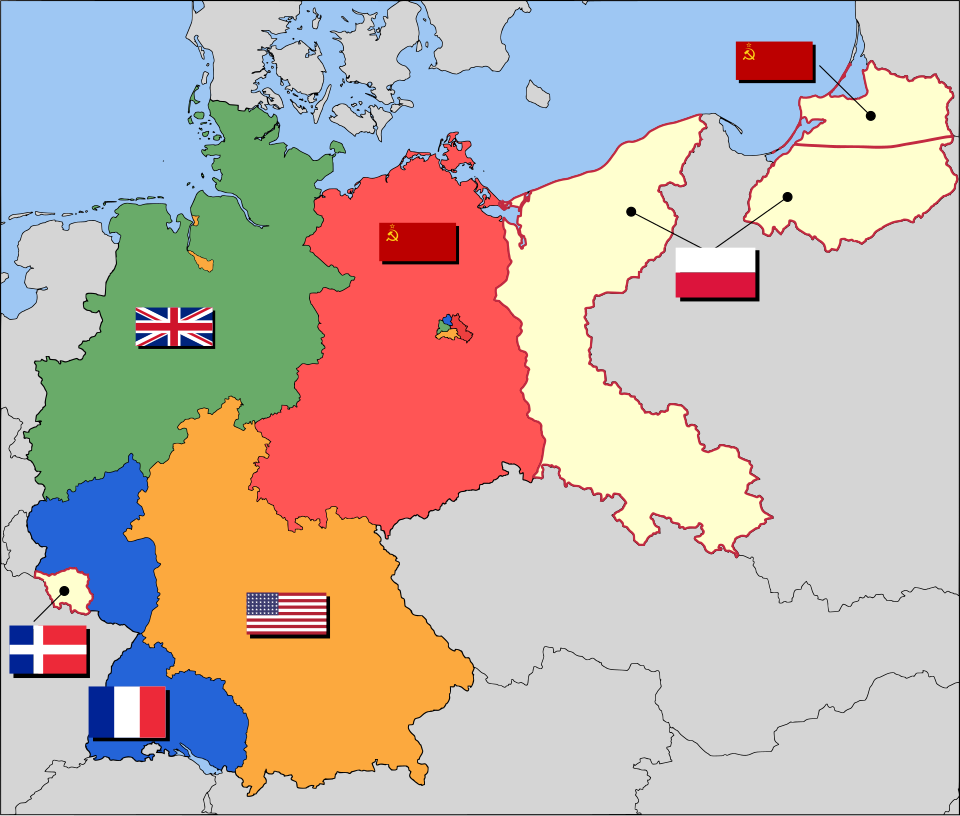OCR Specification focus:
‘conferences: tensions and difficulties at Tehran, Yalta and Potsdam’
The wartime conferences of Tehran, Yalta and Potsdam were pivotal in shaping post-war Europe. They exposed tensions between the Allies and foreshadowed the Cold War.
The Context of the Wartime Conferences
By 1943, the Allies were confident of victory, but questions of peace, territory, and ideology loomed large. The conferences provided structured opportunities for the Grand Alliance—the USSR, the USA, and Britain—to negotiate. Despite a shared commitment to defeating Nazi Germany, ideological and strategic divisions emerged that hardened into post-war conflict.
The Tehran Conference, November–December 1943
Aims and Outcomes
The Tehran Conference was the first meeting of the “Big Three”: Joseph Stalin, Franklin D. Roosevelt, and Winston Churchill. Its major outcomes included:
Agreement to open a second front in Western Europe through the invasion of France (Operation Overlord), relieving pressure on the Soviet Union.
The Soviet Union agreed to join the war against Japan once Germany was defeated.
Discussions about the post-war settlement, including the division of Germany.
Preliminary agreements on shifting Poland’s borders westward.
Tensions and Difficulties
Despite agreements, disputes surfaced:
Suspicion and mistrust: Churchill worried about Soviet intentions in Eastern Europe, especially regarding Poland.
Balance of power: Roosevelt appeared more sympathetic to Stalin than Churchill, seeking Soviet cooperation in creating the United Nations.
Allied unity strained: The conference revealed growing fault lines between Britain’s cautious imperial outlook, Roosevelt’s liberal internationalism, and Stalin’s security-driven priorities.
The Yalta Conference, February 1945
Agreements Achieved
The Yalta Conference occurred when Germany’s defeat was imminent.
Outcomes included:
Division of Germany: Agreement to divide Germany into four occupation zones (USA, USSR, Britain, and later France).
United Nations: Plans for the formation of the UN were finalised, with the USSR guaranteed a permanent seat on the Security Council.
Poland: The principle of free elections in Poland was agreed, alongside recognition of a Soviet-influenced provisional government.
Japan: Stalin pledged to enter the war against Japan within three months of Germany’s surrender.
Underlying Tensions
Ambiguity over Poland: While free elections were promised, Stalin’s dominance in Poland undermined Allied trust.
Democracy vs. control: Roosevelt hoped for genuine democracy, whereas Stalin prioritised Soviet security and a buffer zone in Eastern Europe.
Future of Germany: The division was agreed, but questions about its long-term unity and reparations remained contested.
Free Elections: A political process in which citizens are allowed to choose their government representatives without coercion, censorship, or external interference.
The failure to specify mechanisms for ensuring free elections in Eastern Europe left a dangerous grey area, later exploited by the Soviet Union.
The Potsdam Conference, July–August 1945
Changing Context
By Potsdam, the situation had transformed:

At Potsdam, Attlee, Truman and Stalin confer in the garden at Cecilienhof. This image illustrates the leadership transition and the altered negotiating climate that marked a more adversarial stage in East–West relations. Source
Germany had surrendered in May 1945.
Roosevelt and Churchill were replaced by Harry Truman and Clement Attlee.
The USA had successfully tested the atomic bomb.
Agreements Made
Germany: Confirmation of disarmament, demilitarisation, and denazification.
Prosecution of war criminals: Agreement on trials at Nuremberg.
Territorial adjustments: Germany lost eastern territories to Poland and the USSR; the Oder–Neisse line became Poland’s provisional western border.

A post-war occupation map of Germany showing the U.S., British, French and Soviet zones, along with Berlin. It also depicts territories east of the Oder–Neisse line under Polish and Soviet administration. Source
Growing Tensions
Atomic diplomacy: Truman informed Stalin about the atomic bomb, straining trust. Stalin, already aware through intelligence, accelerated Soviet nuclear ambitions.
Eastern Europe: Truman objected to Soviet control over Eastern Europe, particularly Poland, accusing Stalin of breaking the Yalta commitments.
Reparations: Disagreement persisted; Stalin wanted extensive reparations from Germany, while Truman feared economic collapse would spread communism.
Atomic Diplomacy: The use of nuclear weapons or nuclear capability as leverage in international negotiations or to influence the actions of other states.
The hardening of attitudes at Potsdam marked the transition from uneasy alliance to open rivalry.
The Conferences as Steps Towards the Cold War
Tehran
Cooperation was evident but suspicion simmered over Poland and Eastern Europe.
Roosevelt’s preference for working with Stalin unsettled Churchill.
Yalta
On the surface, Yalta was a success with significant agreements.
However, vague commitments, especially over Poland, left room for later disputes.
The West and the USSR interpreted democracy differently.
Potsdam
The atmosphere was far more hostile.
Leadership changes introduced new dynamics: Truman’s tougher stance against Stalin contrasted with Roosevelt’s diplomacy.
The use of the atomic bomb shifted the balance of power and increased tensions.
Key Themes Emerging from the Conferences
Ideological differences: Capitalism and democracy versus communism and security concerns dominated discussions.
Poland: The central and most divisive issue, symbolising wider East–West disagreements.
Germany’s future: Divisions over reparations, unity, and occupation policies reflected differing visions for Europe.
Power politics: The conferences demonstrated that military and technological power shaped negotiations as much as diplomacy.
Allied mistrust: Each conference deepened suspicion, paving the way for the Cold War divide.
FAQ
Poland’s location between Germany and the Soviet Union made it strategically vital. For Stalin, control over Poland created a protective buffer zone against future invasions from the West.
For Britain, defending Poland’s independence was tied to its original declaration of war in 1939. Churchill was deeply concerned that Soviet dominance in Poland undermined this principle and set a precedent for the wider region.
This clash between Soviet security concerns and Western commitments to self-determination made Poland the most divisive subject at both Yalta and Potsdam.
Roosevelt believed cooperation with Stalin was essential to secure Soviet support in defeating Japan and establishing the United Nations. He was willing to compromise on Eastern Europe.
Churchill distrusted Stalin, fearing that Soviet influence would dominate Eastern Europe. He advocated firmer guarantees for independence, especially for Poland.
This difference in approach often left Churchill isolated, with Roosevelt appearing to side with Stalin at Tehran and Yalta.
The successful test of the atomic bomb in July 1945 transformed the balance of power. Truman used knowledge of the weapon to strengthen his negotiating position, particularly over Eastern Europe.
Stalin, already aware of the bomb through Soviet intelligence, interpreted Truman’s revelation as a threat. This accelerated Soviet determination to develop its own nuclear programme, deepening mistrust and signalling the beginning of the nuclear dimension of the Cold War.
Roosevelt’s death and Churchill’s election defeat brought in Truman and Attlee, who were less experienced on the world stage.
Truman was more confrontational, openly challenging Stalin’s actions in Eastern Europe.
Attlee, though less forceful than Churchill, represented a government more focused on domestic reform than foreign grand strategy.
These changes created a less cooperative environment and heightened the sense of division.
Yes, several important agreements were reached:
At Tehran, the Allies committed to opening a second front in France, which was a decisive step in defeating Nazi Germany.
At Yalta, the framework for the United Nations was finalised, ensuring a mechanism for future international cooperation.
At Potsdam, the Allies agreed on the prosecution of Nazi leaders at Nuremberg, reinforcing principles of international justice.
These outcomes show that, despite growing tensions, practical collaboration was still possible.
Practice Questions
Question 1 (2 marks)
At which wartime conference was the decision made to divide Germany into four occupation zones?
Question 1 (2 marks)
Award 2 marks for the correct answer: Yalta Conference (February 1945).
Award 1 mark if a student identifies Yalta but also mentions another conference incorrectly (e.g., “Yalta and Potsdam”).
0 marks for Tehran or Potsdam alone.
Question 2 (6 marks)
Explain two reasons why tensions increased between the Allies at the Potsdam Conference in July 1945.
Question 2 (6 marks)
Students must explain two distinct reasons. Up to 3 marks for each reason (1 mark for identification, up to 2 marks for explanation).
Possible reasons include:
Leadership changes: Truman and Attlee replaced Roosevelt and Churchill. Truman took a harder line with Stalin, creating mistrust. (1 mark identification, up to 2 marks explanation).
Atomic bomb: Truman revealed the existence of the bomb, using it as diplomatic leverage, which increased suspicion and accelerated Soviet nuclear ambitions. (1 mark identification, up to 2 marks explanation).
Poland and Eastern Europe: Disagreement over Soviet control and the failure to implement genuine free elections. (1 mark identification, up to 2 marks explanation).
Reparations: The USSR demanded heavy reparations, while the USA feared this would destabilise Germany and promote communism. (1 mark identification, up to 2 marks explanation).
Maximum 6 marks. Credit other valid and relevant points based on accurate knowledge.

